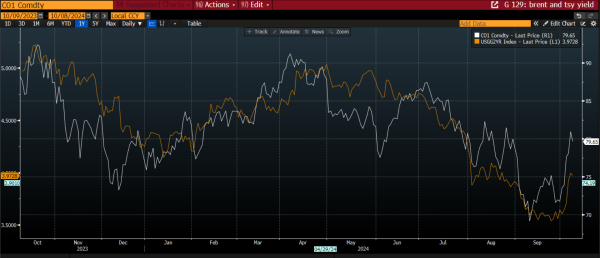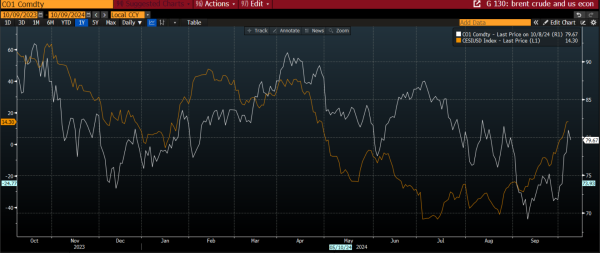Why the US economy still matters for the oil price
The oil price is higher again at the start of this week, as the world marks the poignant anniversary of the Hamas attacks on Israel and ensuing crisis in Gaza and now Lebanon. The oil price has surged by more than 10% in recent days as the geopolitical crisis heats up, and Iran and Israel target each other directly. Investors are now facing up to a potential strike on Iranian nuclear facilities or their oil fields. Added to this, there is a risk that the US, Israel’s biggest ally, gets dragged into the conflict.
This uncertainty is adding a premium to the oil price, and it is understandable why the price of Brent crude rose at its fastest pace in over a year, last week. However, we do not think that it is only the Middle East conflict that is boosting the price of oil, and there could be other factors that may keep the oil price elevated for the long term.
The chart below shows the Brent crude oil price and the 2-year US Treasury yield. As you can see, these two asset classes have a close relationship. The reason for this relationship is a chicken and egg situation: does the oil price impact US Treasury yields, or does the information garnered about the strength of the US economy from US Treasury yields move the oil price?
Chart 1: Brent crude oil and the 2-year US Treasury yield, over the last 12 months.

Source: XTB and Bloomberg
Right now, oil and Treasuries are both moving higher. The US 2-year yield has jumped 45 basis points in a week and breached the key 4% level at one point on Monday. This was the highest level since August. At the same time, the oil price rose more than 2% at one stage on Monday. Thus, the relationship between oil and Treasury yields holds once more. If Treasury yields continue to rise in the coming days, there could be further upside for the price of Brent.
The oil price also has a close relationship with the Citi US economic surprise index, as you can see in chart 2. US economic data has been surprising on the upside since early September, around the same time that the Brent crude oil price bounced off the lows below $70 per barrel. This suggests that US economic data is important for the oil price. Interestingly, the price of Brent crude started to recover when the US economic data showed signs of strengthening. The Middle East crisis has boosted the trend for higher oil prices, but it was not the initial driver.
Chart 2: Citi’s US economic surprise indicator and the Brent crude oil price, over 12 months.

Source: XTB and Bloomberg
Based on the strength of the labour market report for September, the US economy is in good shape. Combined with China stimulus and the Middle East tensions, higher oil prices could be sustained for some time.